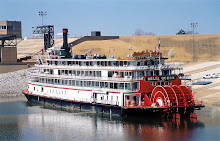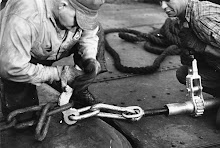
Above is Center Street in Clarksville, looking north, soon after the turn of the century. The photographer has his back to the old covered bridge that spanned the south fork of the creek. The road to the left is Sugar Alley, now the Marianna road. The large lush maple trees line both sides of the dirt street. In the distance can be seen the iron bridge that crosses the north fork. This is my most favorite image of all I have collected. It looks exactly like what one would picture of small town America. Long time residents often described the effect of the trees in summer as " like walking through a tunnel." This is an old undated real photo post card that I purchased about 25 years ago and is a very rare view . This picture is on the cover of Randi Ross Marodi's book The History Of Clarksville Pennsylvania.

This 1930's view shows, in the middle ground, the covered bridge over the south fork. This wooden bridge lasted until it was replaced by the present bridge in 1943. While the covered bridge was being dismantled, it caught fire and burned causing much consternation in town.


Postcard Author's collection
Here is the iron bridge over the north fork and to Washington county, looking northeast. It was built by T. J. Barnard who was a Clarksville resident. The image above was probably made soon after the turn of the century. This iron bridge was dismantled and replaced with the present bridge in 1962. The hill in the background is now occupied by St. Thomas Catholic Church. The buildings that are visible in the distance are unidentified however they may be barns / outbuildings related to the coal mine. Older residents I have spoken to cannot recall anything but hay fields on the east side of the road all the way through Williamstown. Once the coal company came there seem to have never been any other buildings on that side of the road except for the church and the newer Washington Supply company store building. The land to build ( in 1935 ) St. Thomas was donated by the Hillman Coal and Coke Company. An exception also was the relatively modern Paletta discount house whose concrete block foundation still exists near the forks of the creek below St. Thomas Church.

This is from Caldwell's Atlas of 1876. This map implies a ford across the north fork ( at the north end of Center street ) near the forks of the creek. In the map's left hand edge, at the end of Main street is a small bridge that spanned Ten Mile and crossed to what was long known ( even into the late 1940's ) as the Corbett's Mill section which included the old stone ( these days called the Yablonski ) house.
This bridge was an iron truss type with a plank floor and it lasted until sometime after 1939. My opinion is that this was the site of the original, and likely for a time the only bridged crossing of the creek. I say that because of the extensive industries worked at Corbetts Mill, including a grain mill, a sawmill, a distillery and even for a time an iron furnace, all dating far back to the turn of the 19th century and owned at different times by several of Clarksville's leading businessmen. The Corbetts Mill area was therefore, for decades, the important "industrial suburb" of Clarksville. Both of the north fork bridges are visible below in this pre 1919 photo of the northern end of town.
In 1918-1919 the railroad ( PRR, then the Chartiers Southern Railway ) built two bridges, one across each fork of Ten Mile for trains. Two piers beside the north fork span remain, obviously built to carry but a single track.. Later, at a time not yet determined , the railroad built the present larger bridges, capable of holding multiple tracks. Also built at this time was the bridge over the tracks for the Dry Tavern road.

Ida Mary Wortman Haftmann Collection
Clarksville was the site of the only iron furnace in Greene county. It was across the south fork of the creek and several sources state all traces were covered by the railroad embankment. The earliest reference to it is 1794 as a " forge and furnace." The Henry Heaton family originally owned the land and operated the furnace and it was next known as Greene Iron Works, Henry Heaton owning one sixth along with with Jesse Bowell, Ephraim Coleman and forgemen Lock West, James Young and Henry Gillock. It was sold to James Robinson in 1805. A small town was actually laid out on these two acres with 6 house lots laid out to the southwest of " main street ." The establishment was abandoned before 1820, but the stack was visible for some time after 1840. Another source says it was out of blast in 1810. It was also known, as time went on, as Mary Ann Furnace, Clarksville Furnace, Greene Forge and Robinson's Furnace. A newspaper from Uniontown, the Genius of Liberty & Fayette Advertiser, ran the following ad on Aug. 4, 1810:
VALUABLE PROPERTY FOR SALE... THE IRON WORKS... on Ten Mile Creek, late the property of Capt. James Robinson, adjoining the town of Clarksville... and not distant three miles from the Monongahela River... One Hundred Acres of land, Ore Bank... signed Samuel Harper, Agent, dated Greene County, July 23, 1810.......This from the Geological Survey of Pennsylvania 1876-8:
Data on the ores used at Clarksville Furnace, Clarksville, Greene Co.... under the Waynesburg Coal bed in Greene county, the shales contain very moderate quantities of ball ore. Some of it was once dug, at various points in Morgan township, for the old Clarksville furnace.......

Map of Greene Iron Works courtesy of Greene County Historical Library

Author
This 2009 image shows the area of the Iron Furnace and town of Greene Iron Works, looking more or less southeast, the tracks and trestle are behind the trees in the background. The old 1800's original road to Dry Tavern wound up the hill from this point. The oldest residents recall that this area above was known as Furnace Hill. Now locally known as South Clarksville, it's main street is Robinson Avenue, named after the Robinson furnace family.





































 This is an 1902 banknote from the First National Bank of Millsboro Pa. This bank went out of business in the early 1930's.
This is an 1902 banknote from the First National Bank of Millsboro Pa. This bank went out of business in the early 1930's.





























